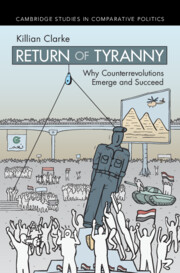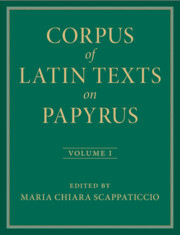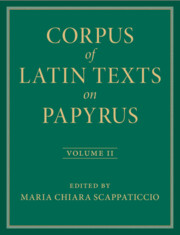Refine search
Actions for selected content:
488 results
8 - Conclusion
-
- Book:
- Return of Tyranny
- Published online:
- 17 September 2025
- Print publication:
- 23 October 2025, pp 234-248
-
- Chapter
- Export citation
6 - A Popular Mobilization and Egypt’s Counterrevolution
-
- Book:
- Return of Tyranny
- Published online:
- 17 September 2025
- Print publication:
- 23 October 2025, pp 170-202
-
- Chapter
- Export citation
5 - Political Elites and Egypt’s Counterrevolution
-
- Book:
- Return of Tyranny
- Published online:
- 17 September 2025
- Print publication:
- 23 October 2025, pp 118-169
-
- Chapter
- Export citation
1 - Introduction
-
- Book:
- Return of Tyranny
- Published online:
- 17 September 2025
- Print publication:
- 23 October 2025, pp 1-17
-
- Chapter
- Export citation
Chapter 2 - Leadership in Rural Pharaonic Egypt
-
-
- Book:
- Leadership in the Ancient World
- Published online:
- 14 September 2025
- Print publication:
- 16 October 2025, pp 34-57
-
- Chapter
- Export citation

Return of Tyranny
- Why Counterrevolutions Emerge and Succeed
-
- Published online:
- 17 September 2025
- Print publication:
- 23 October 2025

Corpus of Latin Texts on Papyrus
-
- Published online:
- 12 September 2025
- Print publication:
- 04 September 2025

Corpus of Latin Texts on Papyrus
-
- Published online:
- 12 September 2025
- Print publication:
- 04 September 2025
Church N1 at ‘Marea’/Philoxenite: an outstanding example of Late Antique sacral architecture
-
- Journal:
- Antiquity , First View
- Published online by Cambridge University Press:
- 09 September 2025, pp. 1-8
-
- Article
-
- You have access
- Open access
- HTML
- Export citation
A Roman fibula from a transcontinental port on the fringes of the Empire
-
- Journal:
- Antiquity , First View
- Published online by Cambridge University Press:
- 11 August 2025, pp. 1-5
-
- Article
-
- You have access
- HTML
- Export citation
Listening to Shaykh Imam: Music, National Belonging, and the Egyptian Left
-
- Journal:
- International Journal of Middle East Studies , First View
- Published online by Cambridge University Press:
- 04 August 2025, pp. 1-23
-
- Article
-
- You have access
- Open access
- HTML
- Export citation
18 - Glass
- from Part II - Artefacts and Evidence
-
- Book:
- The Cambridge Encyclopaedia of Late Antique Art and Archaeology
- Published online:
- 04 July 2025
- Print publication:
- 31 July 2025, pp 349-359
-
- Chapter
- Export citation
HECATAEUS OF MILETUS FR. 310 JACOBY: A DISPLAY OF COLLECTIVE GREEK IDENTITIES IN EGYPT OR A NAVIGATION MANUAL?
-
- Journal:
- The Classical Quarterly , First View
- Published online by Cambridge University Press:
- 31 July 2025, pp. 1-17
-
- Article
-
- You have access
- Open access
- HTML
- Export citation
109 - Theophilus, the Chronicler of Alexandria, Chronography
-
- Book:
- The Fragmentary Greek Chronicles after Eusebius
- Published online:
- 11 September 2025
- Print publication:
- 24 July 2025, pp 373-393
-
- Chapter
- Export citation
104 - Panodorus, Chronography
-
- Book:
- The Fragmentary Greek Chronicles after Eusebius
- Published online:
- 11 September 2025
- Print publication:
- 24 July 2025, pp 190-214
-
- Chapter
- Export citation
105 - Annianus of Alexandria, Chronography
-
- Book:
- The Fragmentary Greek Chronicles after Eusebius
- Published online:
- 11 September 2025
- Print publication:
- 24 July 2025, pp 215-309
-
- Chapter
- Export citation
103 - Metrodorus, Chronicle and Easter Cycle
-
- Book:
- The Fragmentary Greek Chronicles after Eusebius
- Published online:
- 11 September 2025
- Print publication:
- 24 July 2025, pp 184-189
-
- Chapter
- Export citation
An early ruler etched in stone? A rock art panel from the west bank of Aswan (Egypt)
-
- Article
-
- You have access
- HTML
- Export citation
Notes on the Difficulty of Studying State Archives in Egypt
-
- Journal:
- Comparative Studies in Society and History , First View
- Published online by Cambridge University Press:
- 07 July 2025, pp. 1-26
-
- Article
-
- You have access
- Open access
- HTML
- Export citation
15 - Shenoute of Atripe, I See Your Eagerness (Discourses 5, Work 1) and Some Kinds of People Sift Dirt and Whoever Seeks God Will Find (Discourses 5, Works 2 and 3)
- from Part II - Forming and Overseeing the Community
-
-
- Book:
- The Cambridge Edition of Early Christian Writings
- Published online:
- 19 May 2025
- Print publication:
- 12 June 2025, pp 260-290
-
- Chapter
- Export citation
